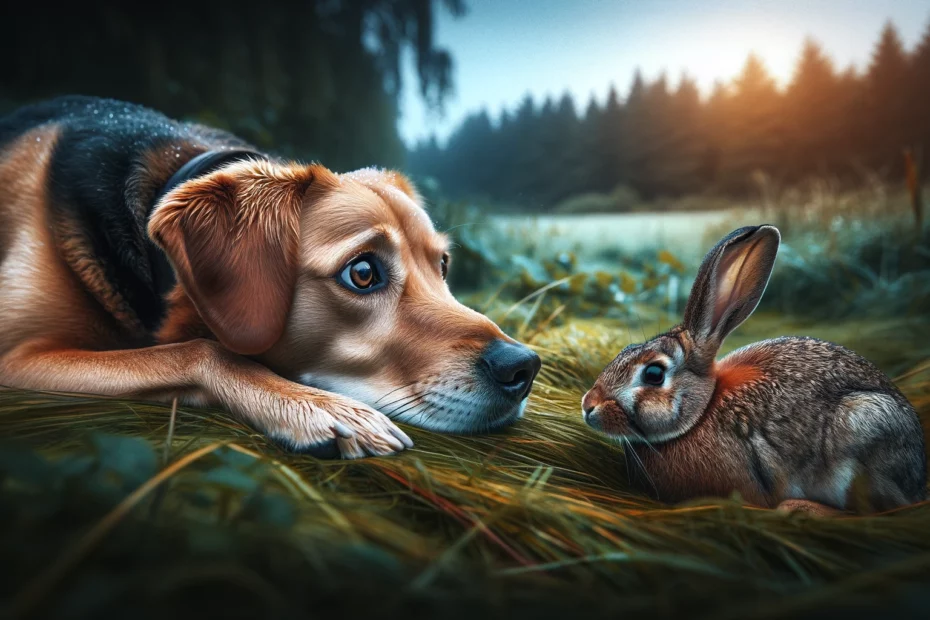Do you ever wonder why dogs have a strange fascination with rolling on dead animals? It may seem gross and inexplicable, but there are actually a few reasons behind this peculiar behavior.
Dogs do this to mark their territory and keep other scavengers away, just like how you claim your spot on the couch. They also inherited this habit from their wild wolf ancestors, who used it to hide their scent from prey.
And believe it or not, rolling on dead animals is a way for dogs to communicate with their furry friends and show off their exciting discoveries.
So, while it may be a bit strange to us, rolling on dead animals is just another quirk in the fascinating world of our canine companions.
Key Takeaways
- Dogs roll on dead animals to mask their natural scent and effectively sneak up on prey.
- Rolling on dead animals is a form of communication and territory marking among dogs.
- Some dogs enjoy the smell of dead animals, but not all dogs exhibit this behavior.
- Training can help redirect dogs’ attention and curb the behavior of rolling on dead animals.
Instinctual Behavior
To understand why dogs roll on dead animals, it’s important to explore their instinctual behavior. Dogs, as descendants of wolves, have inherited certain behaviors that were crucial for their ancestors’ survival. Rolling around in a dead animal is one such behavior that serves multiple purposes.
Firstly, dogs roll on dead animals to mask their natural scent. The strong smell of an animal carcass can overpower their own scent, making them less detectable to potential prey. This allows them to approach their targets more stealthily, increasing their chances of a successful hunt.
Secondly, rolling in dead animals allows dogs to communicate with other dogs. By claiming the scent of the dead animal as their own, dogs can send a message to other canines in the area that they’ve found a valuable resource. This helps them establish dominance and prevent competition for food or other resources.
Additionally, some dogs may simply enjoy the smell of a dead animal. The strong, pungent odor may be appealing to their senses, providing them with a source of enjoyment or stimulation.
Scent Marking
You can understand a dog’s behavior of rolling on dead animals by considering their instinctual need for scent marking. Scent marking is a natural behavior in dogs that serves several purposes. When a dog rolls on a dead animal, they’re essentially leaving their scent on it. This scent acts as a form of communication with other dogs, conveying information about the dog’s presence, territory, and findings. By claiming a dead animal as their own, dogs are essentially marking it as their territory and preventing potential competition from other dogs. This behavior isn’t only instinctual but also interesting from a behavioral standpoint.
Rolling on dead animals also allows dogs to mask their natural scent. This can be advantageous for hunting, as it helps dogs to be sneakier and approach their prey without being detected. Additionally, some dogs may simply enjoy the smell of the dead animal. While this may seem unpleasant to us, dogs have a much stronger sense of smell and may find the odor intriguing or even pleasurable.
Social Signaling
One common reason why dogs roll on dead animals is to communicate their findings to other dogs. This behavior is known as social signaling, where dogs use certain actions or scents to convey information to their canine companions. Dogs are highly social animals, and communication plays a crucial role in their interactions with other dogs. Rolling in dead animals allows dogs to leave a strong scent on their fur, which can signal to other dogs the presence of food or the location of a potential prey. By rolling around in smelly things like dead animals, dogs are able to gain information and share it with their pack members.
When dogs sniff each other, they can gather a wealth of information about the other dog’s health, emotional state, and recent experiences. Rolling in dead animals enhances this information-sharing process, as the strong smell of the carcass can provide additional details about the source of the scent. This behavior is deeply ingrained in their instincts, harkening back to their ancestors’ hunting and survival tactics. By claiming the scent of the dead animal as their own, dogs are able to assert their dominance and territoriality, signaling to other dogs that they’ve made a significant discovery.
Although rolling in dead animals may seem unpleasant to us, it serves an important purpose for dogs in their social interactions. It’s a natural and instinctual behavior that allows them to communicate and gain information from their environment.
Disguising Their Own Scent
Dogs roll in dead animals to mask their own scent, making it harder for other animals to detect them. This behavior is deeply ingrained in their genetic makeup and stems from their wolf ancestors. By disguising their natural scent, dogs can become sneakier hunters and increase their chances of catching prey.
Rolling in dead animals also serves as a form of communication with other dogs, allowing them to claim the scent as their own and mark their territory. The strong smell of the dead animal masks their own scent, making it difficult for other animals to track or identify them.
It’s important to note that dogs may engage in this behavior not only for practical reasons but also because they find the scent of dead animals to be pleasant or intriguing. While preventing this behavior can be challenging, training recall and offering desirable treats can be effective ways to deter dogs from rolling in dead animals.
Seeking Thrills and Sensations
Dogs may seek thrills and sensations by rolling on dead animals due to the unique and intense smells they emit. This behavior can be attributed to their heightened sense of smell and their innate curiosity to explore their environment.
Rolling on dead animals may provide dogs with a sensory experience that’s stimulating and intriguing to them.
Why Seek Thrills
Ever wondered why your canine companion seeks thrills and sensations? Dogs have a natural instinct to explore and investigate their environment. When they come across something smelly, like a dead animal, it piques their curiosity.
The scent of a deceased creature contains a wealth of information for a dog. It signals that there may be something interesting or potentially valuable nearby. This is why your dog starts rolling around when they find a dead animal. Rolling in it allows them to acquire the scent and carry it with them, acting as a form of communication with other dogs.
However, it’s important to stop your dog from rolling in dead animals and to stay away from them. Dead animals can carry harmful bacteria and parasites that can pose a risk to your dog’s health.
Sensations and Experiences
When seeking thrills and sensations, your canine companion is driven by their instinct to explore and experience their environment. Dogs have a keen sense of smell, which allows them to detect various scents in their surroundings. This includes the strong and unpleasant odor of dead animals.
It isn’t uncommon for dogs to be attracted to these smells and exhibit a behavior known as rolling in dead animals. When a dog starts to roll around in smelly, dead things, it’s likely seeking a sensory experience that brings it pleasure. The foul odor may stimulate the dog’s senses, providing a unique and exciting sensation.
Even after rolling in the dead animal, the dog may still exhibit a sense of satisfaction and contentment. It’s important to understand that this behavior is deeply rooted in their genetic makeup and may be challenging to eliminate entirely.
Natural Cleaning Behavior
One way dogs naturally clean themselves is by rolling on dead animals. This behavior may seem strange to us, but it’s rooted in their instinctual cleaning behavior. Dogs have a keen sense of smell and rolling in dead animals allows them to mask their natural scent. By doing so, they can sneak up on prey more effectively.
Rolling in dead animals also serves as a way for dogs to communicate with other dogs. It’s a form of marking their territory and sharing information about their findings. Additionally, dogs may roll in dead animals to claim them as their own and prevent competition from other animals.
While it may seem unappealing to us, some dogs actually enjoy the smell of dead animals. It’s important to note that not all dogs exhibit this behavior. If you find that your dog has a tendency to roll in dead animals, you can try to train them to avoid doing so. Consistent training and redirecting their attention to more appropriate behaviors can help curb this natural cleaning behavior.
Frequently Asked Questions
Why Did My Dog Roll on a Dead Animal?
Your dog rolled on a dead animal due to its behavioral instincts. Dogs are attracted to the scent, driven by curiosity, and engage in this social behavior as a way of marking territory and communicating with other dogs through sensory exploration and communication signals.
How Do You Clean a Dog That Rolled in a Dead Animal?
To clean a dog that rolled in a dead animal, use fragrant degreasing shampoo to remove the odor. Bathe your dog thoroughly, paying extra attention to the affected areas. If needed, seek professional grooming services for stubborn stains.
Why Does My Dog Pick up Dead Animals?
Dogs may be attracted to dead animals due to their instinctual behavior and the strong scent. While rolling on dead animals is a natural behavior, it can pose health risks. Prevention and training can help discourage this behavior.
Why Do Dogs Roll in Other Animals Poop?
When it comes to dogs rolling in other animals’ poop, it’s all about their canine olfactory fascination. It’s an instinctual behavior driven by their curiosity and exploration, as well as their pleasure seeking behavior.
Conclusion
In conclusion, the behavior of dogs rolling on dead animals serves multiple purposes.
It’s an instinctual behavior inherited from wolves and is used for scent marking, social signaling, and disguising their own scent.
Interestingly, a study found that approximately 75% of dogs engage in this behavior.
Understanding the reasons behind this complex behavior can provide valuable insights into the natural instincts and communication methods of our canine companions.






